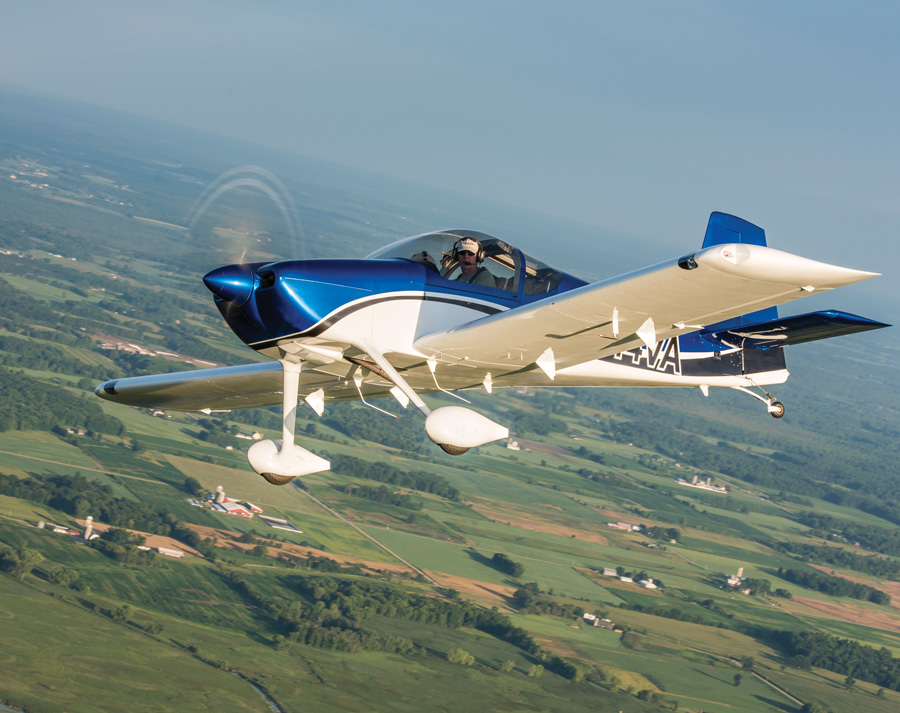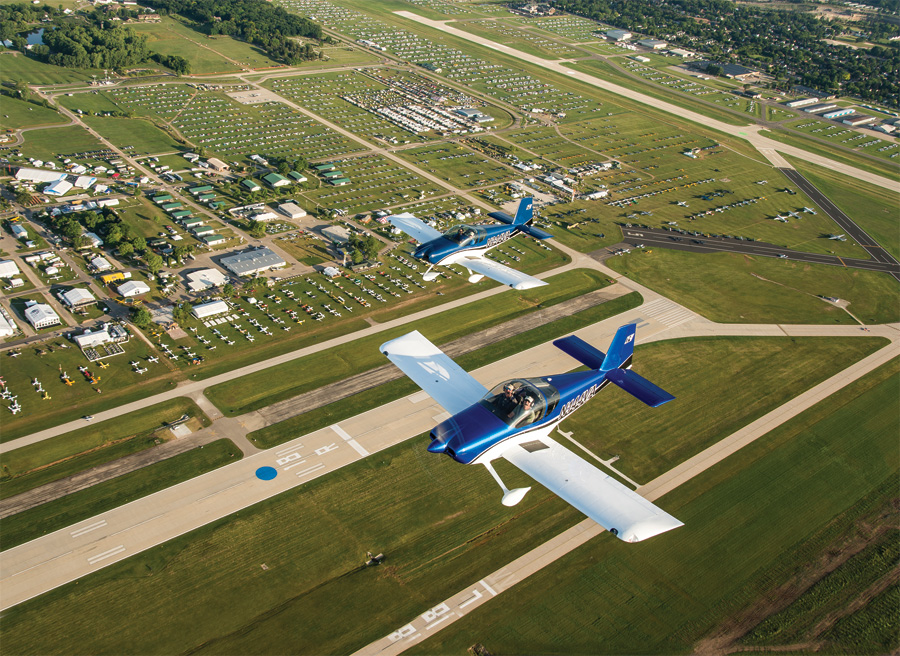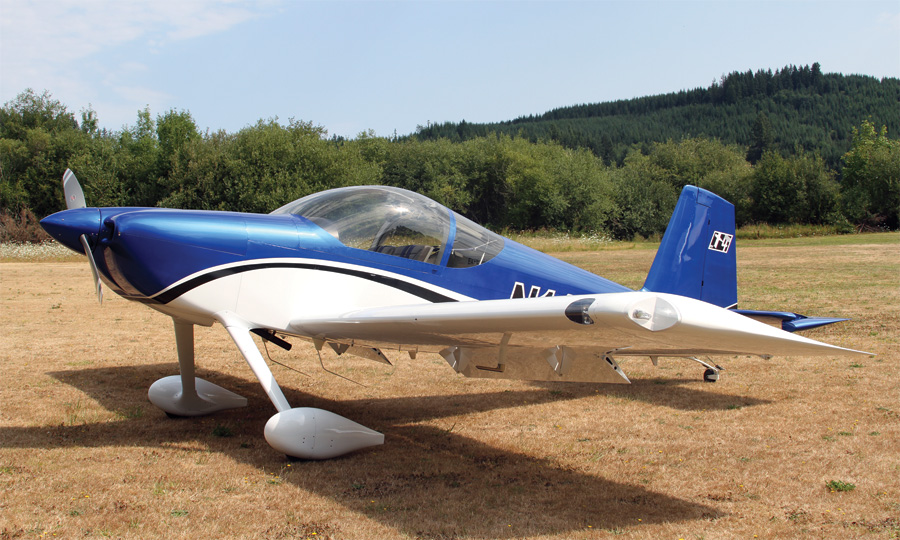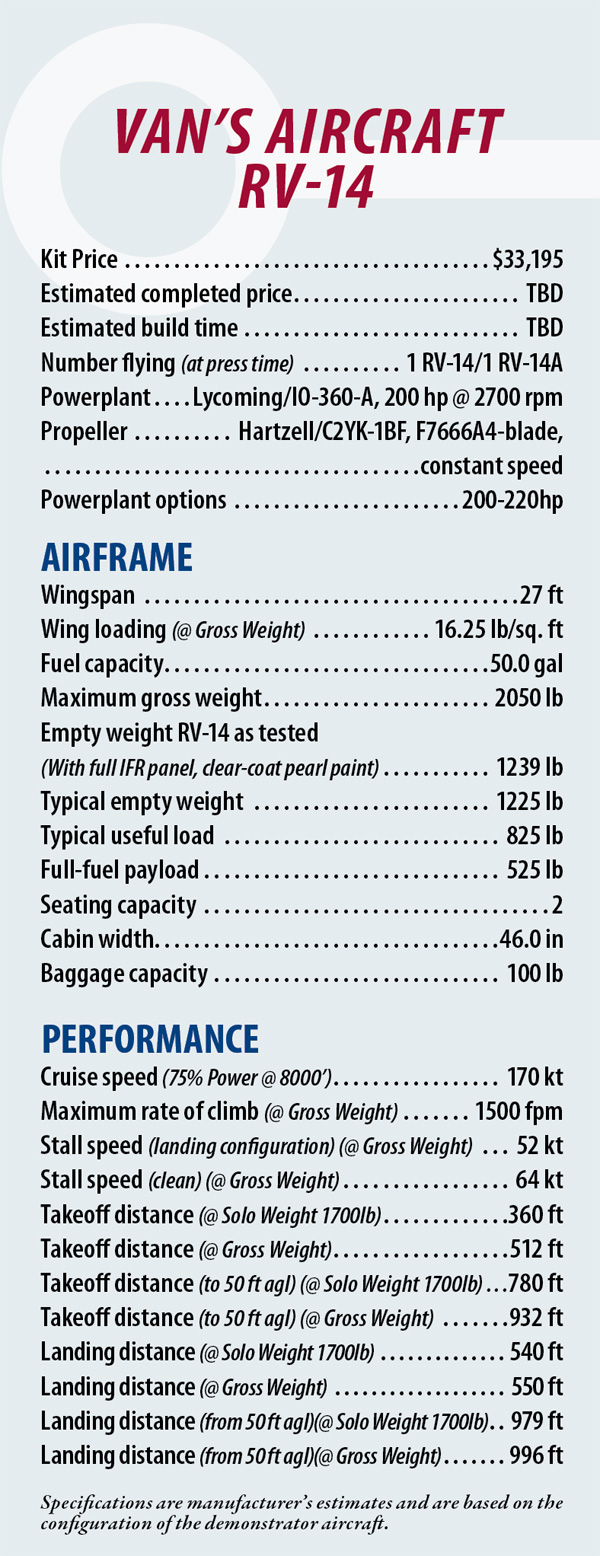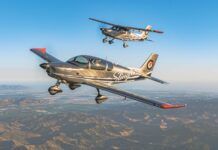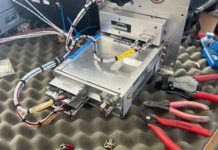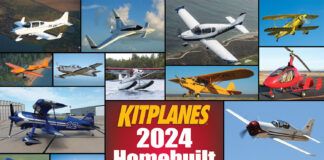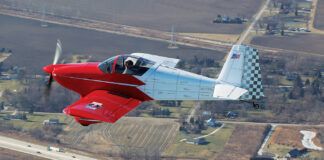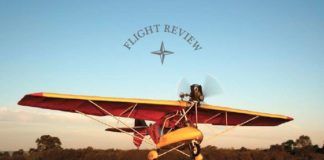“Now let’s stay high this time around, right at pattern altitude until we turn final. When you get lined up, pull the power off, kick full right rudder, and let’s ride it to the ground.”
OK, I figured—this could be interesting in a low-wing traveling machine—a bush-plane approach in the big two-seat RV-14, the latest taildragger to come out of Van’s Aircraft. In the right seat was Mike Seager, the transition trainer for Van’s, with well over 14,000 hours in his logbook, most of it teaching people to fly these remarkable aircraft. “Make sure you feed in a little forward stick when you straighten it out,” he added as we began the elevator descent to the numbers at Scappoose, his normal training field just northwest of Portland, Oregon.
The morning air was smooth and the airplane rock solid as we fell toward the runway. Pitch and roll control was excellent as we slid forward and down, the aim point remaining steady in the lower left corner of the low-cut canopy. Visibility was excellent as I timed the recovery to put me straight about 50 feet off the deck, and the successful outcome of the maneuver was never in doubt. As we squeaked the wheels on just past the threshold, I added power for another go and mentally chalked up a “1” on the Cooper-Harper rating scale for qualitative flight testing: “Excellent, highly desirable. Pilot compensation not a factor for desired performance.”
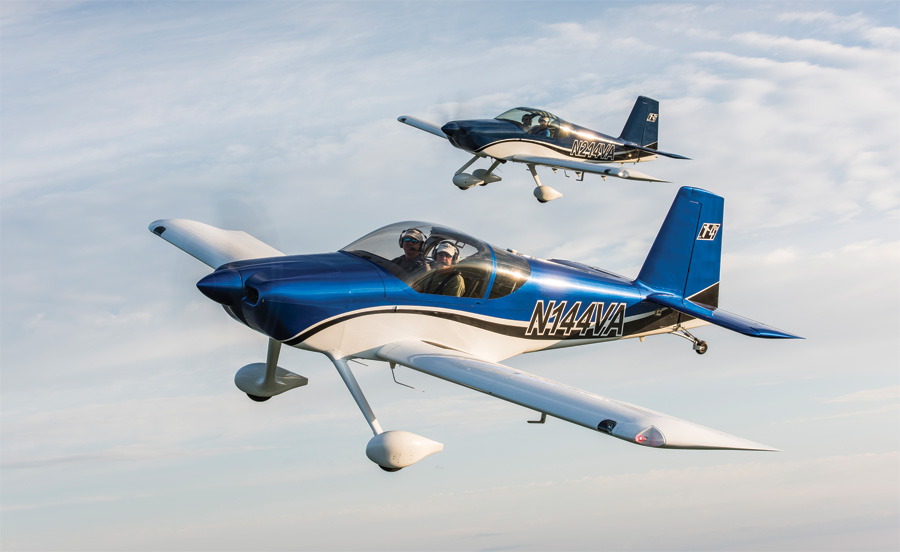
Birds of a feather—the RV-14 (foreground) and the RV-14A. Only the gear will help you tell them apart.
Thank you Messrs. Cooper and Harper—I couldn’t have said it any better myself. The RV-14 is a taildragger that makes the pilot look good.
Updating the Newest of the Fleet
The RV-14 was introduced as a tricycle-gear airplane at Oshkosh in July of 2012. The newest design to come out of Van’s prolific kit company, it was described as a larger alternative to the RV-7, with the cruise performance of an RV-9, but capable of gentleman’s aerobatics. It was designed with a wider cabin and larger baggage compartment to carry today’s modern adults and their gear on long cross-country trips in speed and comfort. Designed around the 210-hp IO-390 engine, the kit was created to be more complete, with better instructions and component quality than anything Van’s had offered before.
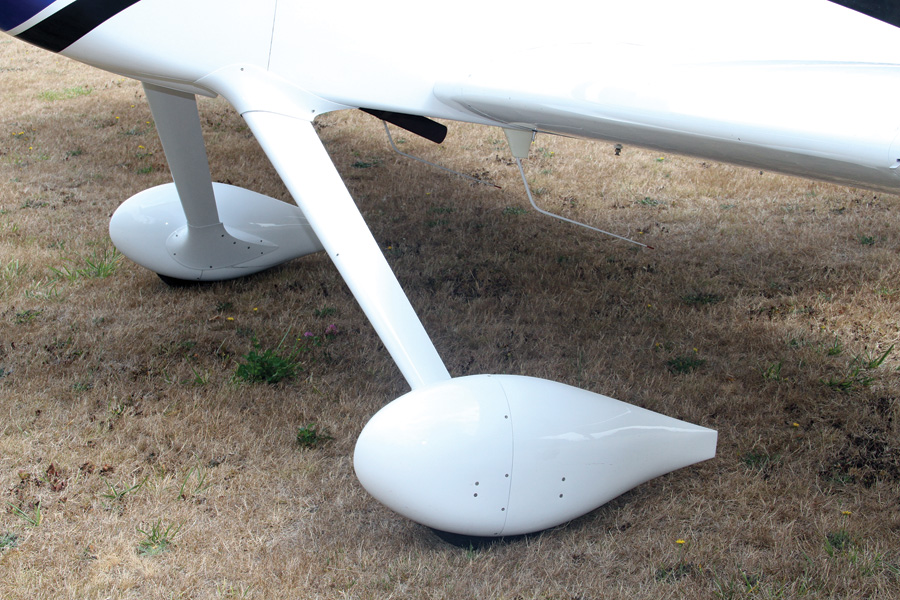
The maingear of the RV-14 attaches to the engine mount, just like on its predecessors, the -6 and -7.
Orders were taken for the wing kit shortly after the Oshkosh introduction, with subsequent kits coming out at intervals longer than many had hoped. Part of the problem was that experienced builders were able to complete each subkit so easily that they quickly ran out of work before the next parts were available. Even with its position as a numbers leader in the kit industry, Van’s is still a small operation. Generating the detailed instructions to go along with the kit components—and making sure that they were readable and accurate—was a monumental task for the tiny engineering staff, so builders were easily able to outpace the team.
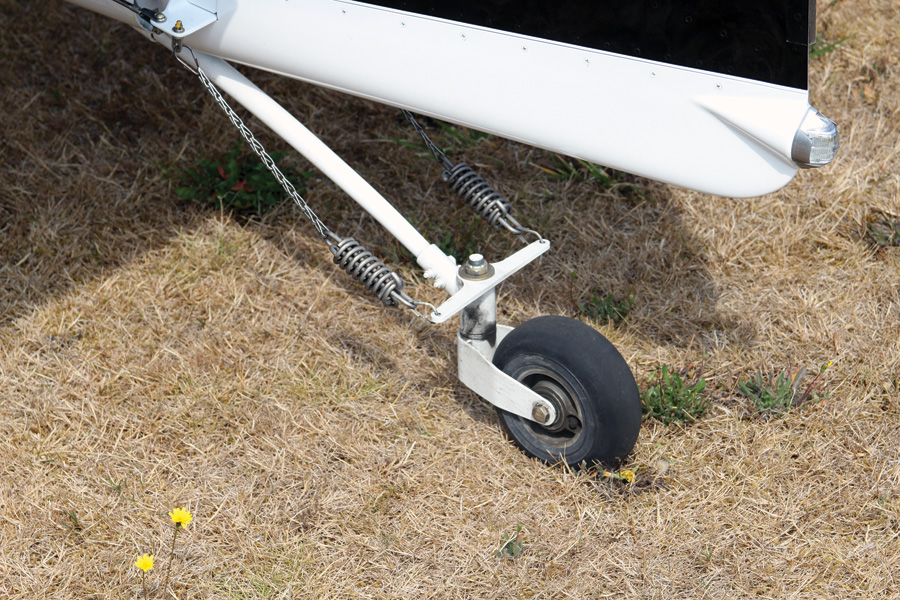
The tailwheel is pure Van’s—dual springs for steering, with a breakout full swivel when you get beyond 30 either side.
When the long-awaited fuselage kit was introduced, the excited crowds still sitting on the fence were pleased to hear that it had been designed to accommodate either a tailwheel or nosewheel configuration. This of course, changed the design designation of the already released version—for everyone knows that Van’s designates its nosewheel designs with an “A” after the number. Therefore, it was decreed that, henceforth and forevermore, the original RV-14 would always be known as the RV-14A, with the previous designation reserved for the version with the little wheel in the back.
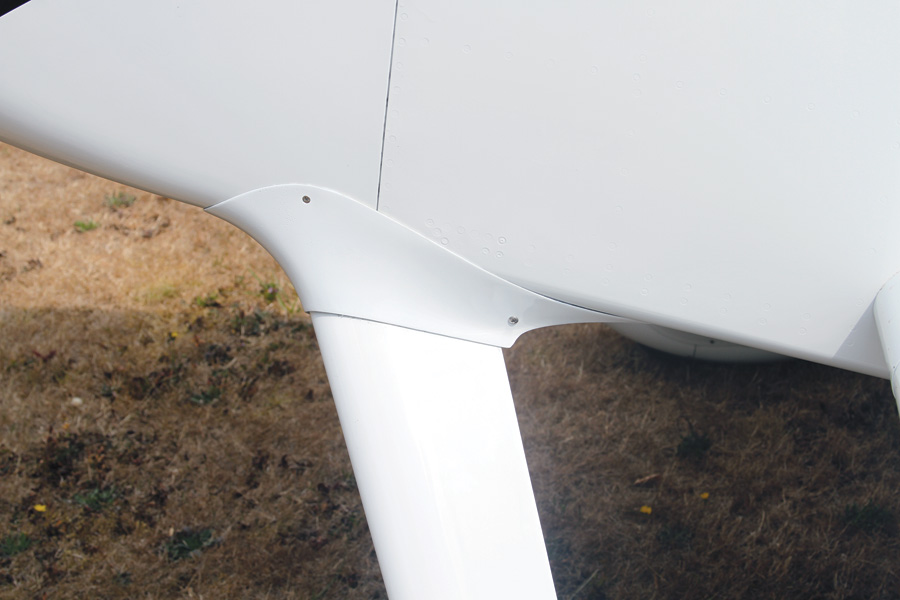
Premolded gear leg fairings will be standard with the RV-14, something that generations of RV builders have lusted for in the past.
There was great anticipation then, when news spread about a month before Oshkosh 2015 that the new RV-14 had flown, was deep into a compressed testing period, and would appear at the AirVenture booth. And appear it did, with many people trampling the grass to create a ghost plane not seen since the tricycle gear predecessor debuted three years before. Many got to sit in the plane and try it on for size, but demo rides were only being given in the tricycle gear version. KITPLANES was offered a chance to fly the airplane as soon as it returned to Oregon from the show, and I couldn’t pass up the chance to once again paste on the RV Grin.
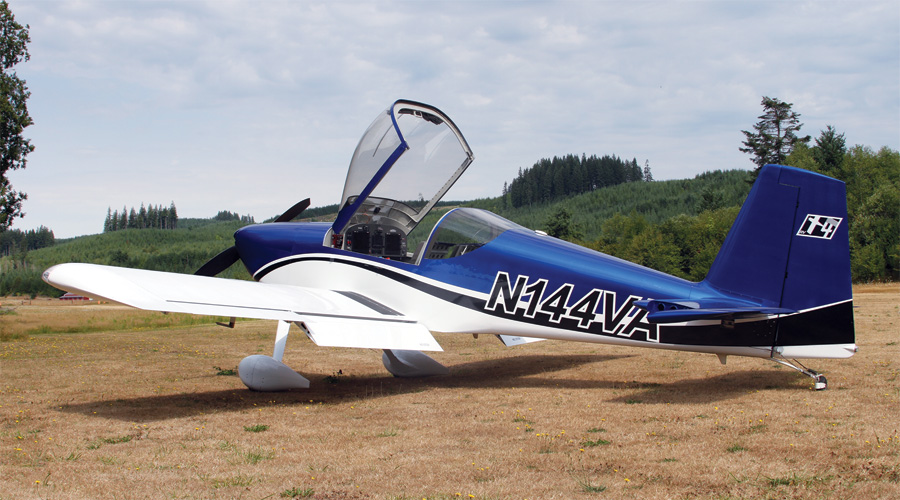
The RV-14 is clearly at home on grass strips—and don’t let the surrounding hills bother you—she’ll drop in steep and soft.
Similar—But Different
I arrived at Van’s on a sunny morning, one week after AirVenture 2015 wrapped up. The RV-14 was ready and waiting, shining in the dappled sunlight, nose held high, poised for the sky. The older -14A was in the shop, getting a good going-over after putting on nearly 600 hours in three short years, but looking none the worse for the wear. I asked about the differences between the two aircraft and wasn’t surprised that the two airframes shared almost every part in common, except for those determining the position of the landing gear. This was a design concept used from day one—make the fuselages common so that the kit could support either configuration.
The tail of the fuselage can support installing the tailwheel spring structure, or it can be left out. The maingear attachment points differ (just as they do with the previous two-seat models), with the tricycle gear mains attaching to the spar, and the legs of a taildragger sprouting from the engine mount. The other differences between the two prototypes are mainly to be found in the instrument panel—the original being supplied with a Dynon SkyView system, and the new taildragger sporting an EFIS from Advanced Flight Systems, mounted in a panel built by AFS.
Firewall forward, the big difference is in the engines themselves. Van’s has frequently used different engines when they build multiple prototypes of the same basic model, and the -14 is no different. The original tricycle gear model is equipped with the IO-390, while the new taildragger is hung with a slightly smaller (but very common) IO-360. Both are angle-valve engines, with the 390 boasting about 10 more horsepower than its sibling. The IO-360 has been used for decades in popular 200-hp aircraft such as the Piper Arrow. Van’s has been inundated with requests from builders about the use of engines other than the new IO-390, and they decided that building the second prototype gave them the opportunity to develop real-world experience and performance numbers with the slightly smaller powerplant.
One other big difference is what’s hanging on the front end of the engine: The original RV-14A is swinging a Blended Airfoil Hartzell, while the new -14 is equipped with the original bladed Hartzell. Both are constant-speed props of course, giving the pilot the flexibility to choose either climb or speed at any time—but the Blended Airfoil prop has proven to provide several knots of additional speed on almost all of the RVs on which it has been tried. Those considering the taildragger should take that into account when reading performance numbers presented here; a BA prop will probably improve them, at least a little.
To the pilot and passenger entering the airplane, the choice of engine is not apparent; only the stance on the ground is visible. The cockpits are identical in size and layout—wide and roomy, with excellent visibility to the sides due to a lowered longeron. The taildragger sits nose-high and proud, but pilots shouldn’t worry too much about a lack of visibility. The high canopy allows room for extra-tall humans, and with eyes high in the bubble, visibility ahead is as good as that from the front seat of an RV-8. Those of us with more standard height can add cushions and bring the seats forward a bit to achieve the same visibility—all without bumping our heads on the Plexiglas. The remaining blind spot to the right of the nose is small enough to be almost inconsequential; S-turning is not really required so long as you don’t slouch.
Steps aren’t included in the tail-dragger version (but can be added), and we didn’t miss them. It is a slightly higher step up to the wing than with the smaller RVs, but nothing the average person can’t handle. Loading the baggage compartment is still done through the open canopy, over the seat backs. While it might be a little easier to load the original tricycle version because the floor is level, it is not much different overall when loading the taildragger. Two people make the job easier, with one standing half in the cockpit, facing aft, and one on the ground, handing luggage up. The baggage area will hold quite a bit, including, it is rumored, a window air conditioning unit used by at least one Van’s employee to cool down the dorm rooms at Oshkosh.

The prototype RV-14 is equipped with dual AFS touchscreens and an Avidyne IFR navigation box—plenty of avionics to get you safely into and out of the clouds.
Settling In
The RV-14’s cockpit was familiar to me, as I have flown the -14A several times already. Controls are easily located and the only real difference is the brand of EFIS installed in the panel. The dual touchscreen AFS units are connected to an Avidyne IFD540, a full-featured IFR navigator and com system that compares well to the Garmin GTN 750. The prototype also features a remote transponder, a second remote radio from AFS, and full ADS-B In and Out capability. All of the avionics and the aircraft’s electrical system are connected through the AFS hub used in the Quick Panel system, making for fast build times and standardizing the RV-14 fleet. Additional EFIS options will be available from SteinAir and AFS, just as they are for the similarly pre-wired RV-12 kit, so those with favorites other than AFS should not turn away.
The prototype that we flew was equipped with very nice wooden stick grips sporting trim, flap, and push-to-talk switches. We’ll talk about the operation of these later, but expect changes as the design and kit is finalized. The seat adjustment is typical Van’s—three different hinge locations are available for the bottom of the seat back to adjust for the pilot’s leg-length, and the seat can be tilted at two different angles by using a hinged brace between the top of the back and the cross-cabin brace. Suffice to say there’s plenty of room for adjustment—and plenty of room for large people. Headset jacks are outside and slightly behind the seats to keep cables out of the way.
Additional seat adjustment is done with cushions, an effective and comfortable way to economically fit the plane to the pilot. My five-foot-eight-inch frame needed the forward-most seat position to accommodate a 30-inch inseam, and we tilted the seat back all the way forward to give me good stick reach. A single
additional cushion brought my eye height up to where I could see nicely over the nose. Additional cushions are always an option for folks who want to sit farther forward or higher—and of course, all of the ex-NFL linebackers lining up to try the airplane can remove cushions as necessary. There appears to be little danger of bumping one’s head on the canopy in either case—this is a roomy airplane. Cabin width is also wonderful. Even for those of use that love being close to our spouse, shoulder room is a great thing to have when launching halfway (or more) across the country on a multi-leg outing that can take all day.
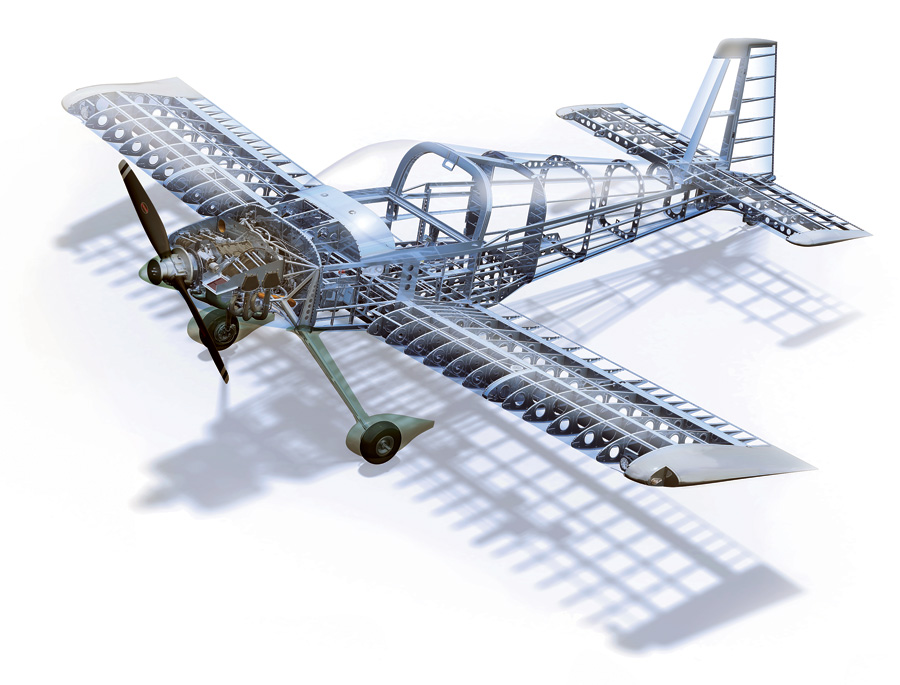
Aviation artist and Van’s employee Adam Burch created this cutaway of the RV-14 using the actual aircraft CAD drawings as a starting point.
Up and Away
The IO-360 fired up with ease, and we were quickly off to test the taxi visibility as we worked our way out of the narrow, winding taxiway that leads from Van’s hangar on the Aurora State Airport. I never felt uncomfortable with the visibility and rate it quite good, not just as taildraggers in general go, but even above other taildragger RVs. The shallower canopy in our very early RV-6 prevents us from sitting terribly high and makes forward visibility a challenge. Not so with the RV-14—the only time I noticed the nose was when looking to the right to see a turn in that direction. Scooting up in the seat helped me to see what I was missing, however, so radical S-turns were not required.
We used the electronic checklist on the EFIS to make sure that the airplane was ready to go, but there was nothing that would surprise any pilot used to an EFIS-equipped airplane. A standard CIGAR list would suffice in a pinch, but it is always nice to go over everything—including nav settings—before taking off. In short order, we were taking the runway for the first takeoff, and with a slow addition of power, we were rolling. The tail came up almost immediately, with liftoff occurring moments later, as the airplane accelerated quickly with half tanks and two people without baggage. Visibility in the climb was outstanding and performance about what you would expect for a 200-hp RV. We quickly closed on a Cessna ahead of us, but also outclimbed it by a wide margin before banking away and heading to the practice area.
Cooling in the climb was far better than I have seen on most RVs. In fact, cooling wasn’t an issue no matter what we did throughout the day. Rian Johnson, chief engineer at Van’s, told us later that the lower CHT and oil temps tell him that he has quite a bit of cooling margin that can be turned into speed with some work on how much air is being fed past the engine (creating drag). So expect more normal temperatures—and faster cruise speeds—in the future.

The RV-14 has the same large baggage compartment as its tricycle-gear brother—plenty for most traveling couples’ needs.
RV-14s—Getting Better All the Time
As one of the first journalists to fly the then-new RV-14A in 2012, I was not surprised that work was still needed in a few areas. One of these was in control harmony—pitch was light, roll was heavier, and Van’s had numerous ideas about how to bring the two axes into better alignment. Now, three years later, I can report that the harmony is as sweet as a barbershop quartet. I like to think of a control motion producing an angular rate in a particular axis for a given amount of force. Harmony is achieved when the same amount of force in any axis provides the same vehicle rate as it does in other axes. If you get the same reaction no matter which direction you move the stick, the airplane feels natural and easy to control.
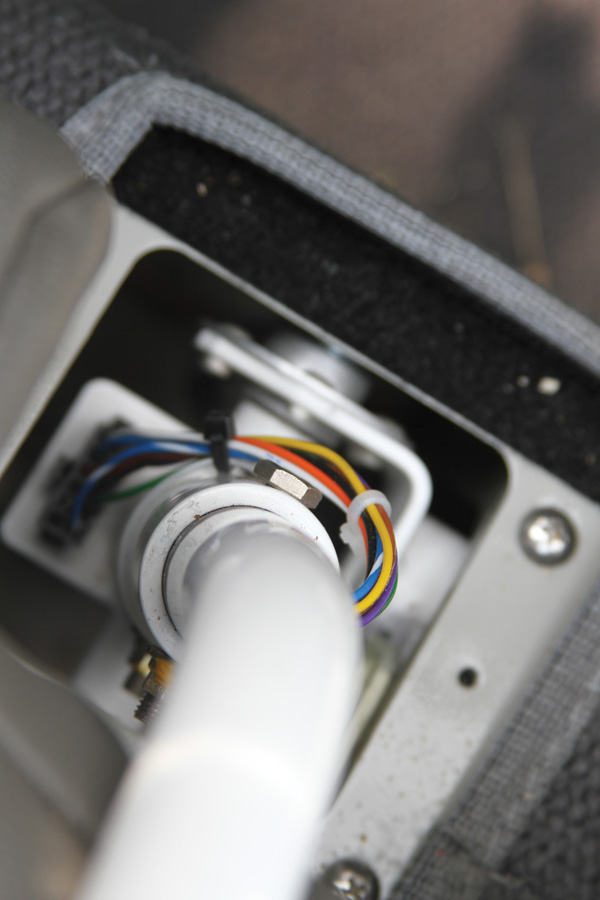
The sticks on the RV-14 (and the -14A) now incorporate ball bearings in the roll axis. This eliminates a source of free-play present in previous RV models.
This harmony has been achieved through careful tailoring of the trailing edges of the elevator, and special attention to friction reduction in the aileron control system. While no one will ever mistake an RV-14 for a lighter and quicker RV-4 or -3, the airplane has a nice stable response, similar to the difference between a touring sedan and a sports car. One is smoother, the other quicker. The changes developed in the RV-14A were incorporated in the RV-14, and improvements made to the -14 were then backed into the -14A, so work on both has improved the breed in general.
We explored the handling qualities of the RV-14 through increasingly steep turns, and I was surprised to find that when I got the bank angle up past 60, I actually had to use a little bit of top rudder to keep the bank from increasing. This is completely normal for most aircraft—the surprise was simply that in most RVs you can fly virtually any coordinated maneuver (including simple aerobatics) with your feet almost flat on the floor. This was one of the first times I had to do much with my legs in an RV at maneuvering speeds. Not objectionable in the least—just a little discovery reminding me that this is a different airplane than earlier Van’s designs.
We eventually steepened the turns into wingovers and then into basic rolls. The airplane was well-behaved throughout and lived up to its promise of allowing the occasional roll for those who want to go upside down only now and again. I wouldn’t give up my RV-3 for aerobatics if faced with a choice between it and an RV-14—but the advantage of the smooth, roomy ride afforded by the -14 is hard to pass up. Again, the visibility afforded by the low canopy sills made maneuvering flight a scenic experience, and orientation was never an issue.
Bumps and Circuits
To tell the truth, once you get away from the ground, it is hard to tell if you are flying an RV with a nosewheel or a tailwheel. It is only when it comes to landings that the configuration makes a difference—and the difference is always significant. I don’t subscribe to the notion that tailwheel pilots are better than tricycle-gear pilots; both require specific skills, and each configuration has its advantages and disadvantages. I grew up with the little wheel in back, but have spent thousands of hours with a wheel dangling under the nose as well. The RV-14 makes it tough to choose a configuration because both handle just fine.
Seager headed us over to his usual training haunt—the runway at Scappoose, Oregon—for some touch and goes. After orienting me to the pattern, he suggested I just go ahead and land however I wanted, then he sat back, and relaxed. The only suggestion he made was that the -14 approaches nice at about 75 knots, so that is what I dialed in as we slowed and dropped flaps. The current flap system design uses a momentary switch on the top of the stick, hooked up to a controller that drops the flaps in increments as commanded by the pilot. Each blip of the switch backwards sends the flaps down to the next step—the first being 5, the second 20, and the third full down. The flap motor is slow, but that is something Van’s is looking into. A quicker rate would allow better pattern operations in my opinion, and chief engineer Johnson agrees.
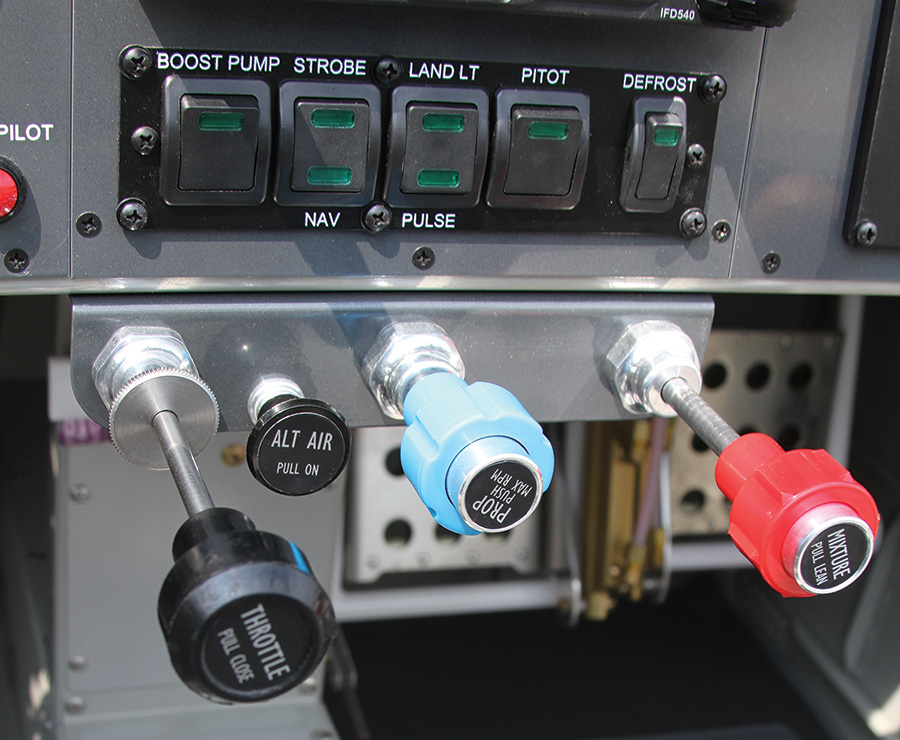
The RV-14 kit comes complete with switch panels and controls—this really is a mature building experience.
Raising the flaps in the current configuration requires that the pilot hold the switch in the up position—or at least blip it to get it to go to each of the three positions on the way up. Since we rarely raise the flaps incrementally in an RV (usually wanting them to go all the way up on a go-around or touch and go), I’d prefer to see a single forward push on the switch take them all the way up. In the case of a go-around, holding the flap switch forward while wanting to get some nose-down trim (which requires the same thumb action, but on the trim switch) puts the pilot in an uncomfortable position at an unfortunate moment. Since the flap switch is located next to the trim switch on the top of the stick, and the two have a similar feel to the thumb, it is easy to confuse the two, and send the flaps in an unwanted direction when actually wanting to trim.
(I was not the first to notice this confusion, however. The crew of pilots at Van’s had already decided to look at different switches and updated software controls for the flaps to make operation of the system more intuitive and in line with a pilot’s real needs. I expect the system will be modified long before customers get their hands on the airplane. There also may be a new grip in the airplane’s future—a shame, actually, because the nice teakwood grips fit the hand very nicely.)
Back to our landings though—the best thing I can say about an airplane is that it is predictable and goes exactly where I want and expect it to go. The RV-14 fits that description to a T. I had been warned that it might feel a little sensitive in pitch during the flare, and while I agree that is an apt description, I found the sensitivity to fit my flying style nicely. It was very easy to adjust pitch attitude for either a three-point or a wheel landing as I settled and slowed on a shallow glideslope for the pavement. In the five landings we did at Scappoose, we got no bounces, and directional control in the flare and after touchdown was excellent. The first landing I did was a wheelie because I wanted to see how things looked over the nose at touchdown and as the tail settled. Subsequent landings were three-pointers, and while I rarely make beautiful touchdowns this way, the RV-14 made me look good—a compliment to the airplane, not the pilot. The third time around, we made the approach without flaps, the fourth time, we made a parachute drop with a full-rudder slip from a very high position on final. Visibility was great and recovery a piece of cake.
The final circuit at Scappoose ended with a short-field landing, and we easily turned off at the 800-foot mark after having to add power after coming to a stop. We guessed we were down and stopped about 600 feet from the threshold, and I might have given away 100 feet in the initial float. If you need to land shorter than that, you might want to reassess your choice of runways.
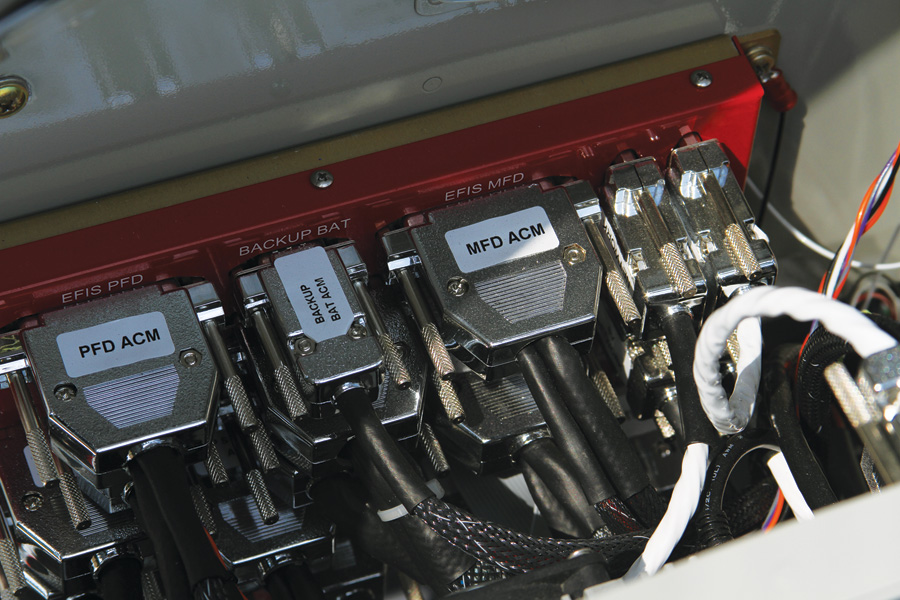
The RV-14 AFS panel features a plug-and-play junction box behind the panel that speeds up building considerably (when used with the Van’s recommended panel configuration).
Almost the Mountains
We took on fuel at Scappoose, but hardly noticed the extra weight as we launched once again, this time for the grass strip that Seager calls home in Vernonia. Climbing quickly to the west, we saw a land of timber and steep hills, with a runway hiding out there somewhere past the small lumber town. Seager appeared to be smiling in the right seat, and I suspect he was wondering if I was going to be able to pick out the runway among the forests and overgrown clear-cuts. It was actually quite easy—I had three moving maps with magenta lines pointing right at it. That’s right, I cheated!
The runway itself is classic mountain rustic—in a valley, with a curving approach through a gap in the trees that reminded me much of the Idaho backcountry, but without the soaring slopes and higher altitudes. We entered on an upwind for 27 to give me the lay of the land, then curved into a decelerating downwind and a continuous base-to-final turn with the threshold hiding behind trees until the last few seconds. The RV-14 handled much like a bush plane—one with a low wing, but good visibility. With the earlier practice at Scappoose it was easy to drop it right on the beginning of the field and then brake to a stop in 1000 feet or so. Yup—load this one up and take it to Johnson Creek any time you want!
How Slow Can You Go?
By the time we’d had a nice lunch in the quaint little town of Vernonia, it was time to head the plane back to Van’s. But along the way, I wanted to sample the slow-flight characteristics to see if they had changed any from the original model. We slowed things down and brought the power back for a power-off stall that could best be described as a non-event. It was hard to get any kind of a break at all; the airplane simply mushed forward, with the nose dropping slowly in what felt like a mini falling-leaf maneuver. Relaxing the backpressure broke the stall, and we were off flying again. Bringing the flaps down, we tried again—and this time were rewarded with a break typical of a Piper Cherokee—benign, slow, and well-mannered. The break occurred at about 47 knots IAS with the flaps out, nearly ten knots slower than with the wing clean.
Adding power to about 75%, we pulled the nose up for a power-on stall. Anyone who has tested their RV for full-power stalls knows what it is like to look almost straight up before the break. While not actually that steep, it sure seems like it. But in the RV-14, the break was gentle and to the right, recovery coming not with a loss of altitude, but simply with a reduction in climb rate. It would be hard to stall the RV-14 without knowing it was coming—and even then, recovery should be quick unless the pilot were truly unconscious. We tried one more trick, an accelerated stall, and got the airplane to break over the top—from a steep left turn into a gentle right bank before relaxing the backpressure to once again let the wing fly. No, if you want to do snap rolls, this is not the airplane for you.
Performance
So how does it perform? That’s one of the biggest questions I had going into this review, having flown the RV-14A several times before. The bottom line is that this RV-14, compared to the only RV-14A in existence, shows numbers comparable to within the accuracy of the instrumentation. That is to say, they are essentially the same. The difference, of course, is that the -14 is getting the same numbers with a slightly smaller engine. And that could be good news for many builders looking for a bargain, since the IO-390 in the -14A is really only available new at this time, and there are IO-360s (as installed in the -14) sitting around in many places, removed from Arrows and Mooneys.
In brief, the factory numbers at gross weight show a cruise speed of 170 knots at 75% power and 8000 feet, with a maximum rate of climb of 1500 fpm at sea level—respectable numbers in all but the most overpowered aircraft. The stall is listed at 52 knots dirty, and 64 knots clean—probably the reason that the airplane feels so good dropping into short strips from steep approaches. Landing and takeoff distances are reliably short, and I verified this on my flight with Seager. Just about any reasonable strip is accessible to the RV-14—and in between strips, you can go like stink.
Now we probably should be cautious about stating categorically that the -14 does more with less because we have only one sample of each aircraft and each engine—and each engine has some history. A definitive determination of which is faster probably needs to wait until we see a few more flying, but I would not hesitate to start shopping for an IO-360 if I were thinking about having an RV-14 in my future.
Summary
So what do I think of the newly named RV-14 (while the original -14 takes its rightful place in the “A” lineup)? With the large cabin and baggage space of its tricycle-gear brother, and the backcountry look and feel of thousands of taildragger RVs that have gone before, this is an airplane that’s easy to like. I married into ownership of (and routinely fly) the RV-6 built from the fourth kit released by Van’s several decades ago, so I have a good grasp of the entire spectrum of the side-by-side RV lineup—and this is a great example of evolution at work. I found the taildragger -14 to be easy to land under just about any condition, or using any technique, with good speed control. It has a great ability to slip off extra altitude and drop into a short, soft strip, and an equal ability to mix with regular high-speed traffic and wheel-land on a long paved runway.
The handling qualities of the airplane have improved, the additional engine choice is going to be welcome for those builders who have handy access to a good used, or core IO-360, and multiple choices for the panel will allow people to build it the way they want it. The taildragger option will please many who are comfortable with the little wheel in back, especially those who frequent rough fields that have never seen a roller or a paving machine.
While I’m aware of the frustration of the long wait for the release of the various subkits for the -14A, the parallel development of the -14 now being completed should free up resources for the final push that should break the logjam. I expect to see a flood of completions as builders start receiving final parts and get their airplanes into the air. I will not be surprised if in future years soon to come, the RV-14 and -14A don’t become the de facto standard of flying RVs. And now, pilots have a choice—the little wheel can go on either end! Take your pick, and build the airplane you want to build.

